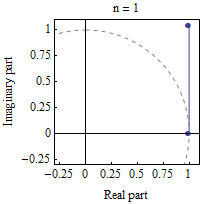Can I interpret the exponential of the derivative operator, $e^D$, as infinite shift operators each shifting "infinitesimally"?
To better explain what I mean, an example can be very useful. Consider $e^{i\theta}$. We could express this using the series definition or the limit definition of $e^x$ instead:
$$e^{i\theta} = \lim_{n\to\infty}\left(1+\frac{\theta}{n}i\right)^n$$
If we want to see visually what's going on as $n$ grows we can look at the following GIF from Wikipedia:
$\hskip2in$
Essentially each factor in the product above as $n$ grows has its norm shrink to $1$ and its angle get "infinitesimally" small. The intuitive idea would be that when you multiply all the factors you add all the (very small) angles to the total $\theta$ and multiply all the norms which in the limit gives $1$.
I've considered applying this intuition to the exponential of the derivative operator, which shifts the function it's applied to:
$$e^{cD} f(x)=f(x+c)$$
I've considered rewriting the derivative operator as a limit in terms of the shift operator, and then insert it into the product definition of the exponential ($I$ is the identity in what follows), where I take $c=1$ for simplicity:
$$Df(x)=\lim_{h\to0}\frac{f(x+h)-f(x)}{h}\equiv\lim_{h\to0}\frac{S(h)-I}{h} f(x)$$
$$e^{D} = \lim_{n\to\infty}\left(1+\frac{1}{n} \lim_{h\to 0}\frac{S(h)-I}{h} \right)^n$$
The only way I see to get to the exponential being the composition of a lot of "small" shift operators is if we evaluate the double limit along $h=1/n$ (or $n=1/h$ alternatively) in which case the above simplifies and we get $e^{D}=\lim_{n\to\infty}S^n(1/n)=S(1)$ but I cannot think of any way to justify taking that specific path, $h=1/n$, when evaluating the limits.
To sum up, I would like help with two things:
- Is it conceptually sound to interpret the $e^D$ in the above manner?
- If it is, can I prove with some rigour the above intuition?
Thank you for your time.
I think your intuition makes perfect sense, but the way you're going about the proof might be a little awkward.
Let's do this instead: $$e^Df = \lim_{n\to\infty}\left(1+\frac Dn\right)^nf.$$ But $$\begin{align} \left(1+\frac Dn\right)f &= f+\frac1nf', \\ S_{1/n}f &= f + \frac1n f' + O(1/n^2), \end{align}$$ at least when $f''$ is bounded. So each $(1 + D/n)$ operation is like a little shift, and $$\begin{align} e^Df &= \lim_{n\to\infty}\bigl(S_{1/n}+O(1/n^2)\bigr)^nf \\ &= \lim_{n\to\infty}\bigl((S_{1/n})^n+O(1/n)\bigr) f \\ &= S_1 f. \end{align}$$
No, it is not infinitesimal shift operations coming together to form one large finite shift. Only when you sum up the whole "taylor expansion" of the exponential derivative, will you end up with anything that looks like the original function, shifted.